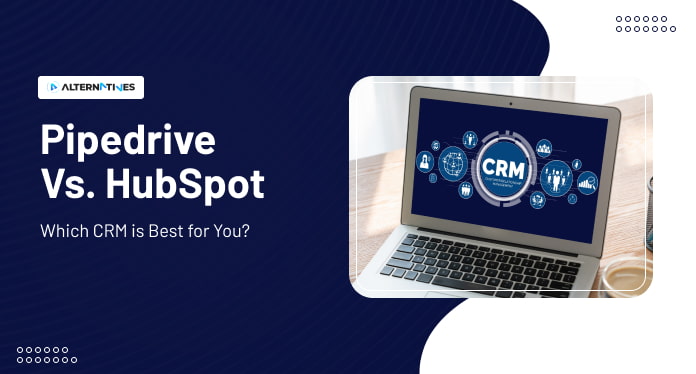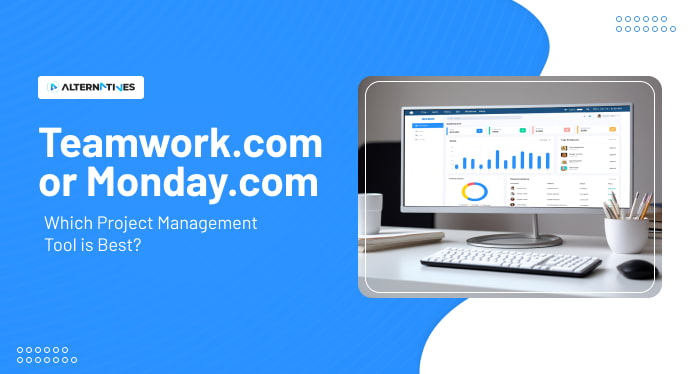Pipedrive Vs. HubSpot: Which CRM is Best for You?
pipedrive-vs-hubspot

Choosing the right CRM is crucial for optimizing your business processes. In the world of Customer Relationship Management (CRM) software, two of the most popular and widely used options are Pipedrive and HubSpot. Both offer a variety of features to help businesses manage their customer relationships effectively, but which one is best for your organization? In this article, we’ll compare these two CRMs side by side, looking at their features, pricing, ease of use, integrations, and more so you can make an informed decision about which one is best for your business.
A Quick Overview of Pipedrive
Pipedrive, a leading CRM, excels in streamlining sales through robust lead and deal management. With features like data import/export, email scheduling, and two-factor authentication, it ensures efficiency and security. Integrating Pipedrive enhances analytical capabilities, providing deeper insights. For those exploring options, consider Pipedrive alternatives while evaluating these comprehensive features to ensure the perfect fit for your business needs and data security requirements.
A Quick Overview of HubSpot
HubSpot, a versatile CRM, offers user management, a product library, forms, team email, SSL certificate, live chat, landing pages, site segmentation, and CTAs. These features streamline marketing and sales efforts. Integrating Pipedrive enhances analytical capabilities, providing deeper insights into data. For those exploring alternatives, HubSpot alternatives offer diverse options. Evaluate these features to ensure your CRM aligns seamlessly with your business needs and objectives.
Features Comparison For Pipedrive Vs HubSpot
| Feature | Pipedrive | HubSpot |
| Lead and Deal Management | Pipedrive ensures efficient tracking and management of leads and deals through customizable pipelines and an intuitive interface. | HubSpot provides robust lead and deal management tools, offering detailed insights and seamless collaboration within teams. |
| Data Import and Export | Pipedrive facilitates easy data import/export, streamlining migration and ensuring data consistency. | HubSpot offers smooth data import/export functionalities, simplifying the transfer of information for efficient CRM use. |
| Email Scheduling | Pipedrive allows users to schedule emails, ensuring timely communication with prospects and clients. | HubSpot provides email scheduling capabilities, enabling strategic communication and engagement planning. |
| Two Factor Authentication | Pipedrive prioritizes security with two-factor authentication, adding an extra layer of protection to user accounts. | HubSpot offers enhanced security through two-factor authentication, safeguarding user access and data integrity. |
| Security Dashboard | Pipedrive’s security dashboard provides a centralized view of security metrics, ensuring transparency and proactive risk management. | HubSpot’s security dashboard offers comprehensive insights into account security, allowing users to monitor and address potential threats. |
| User Management | Pipedrive provides robust user management tools, allowing administrators to control access and permissions effectively. | HubSpot’s user management features enable seamless collaboration by assigning roles and permissions to team members. |
| Product Library | Pipedrive’s product library helps organize and manage product information, aiding sales teams in presenting offerings effectively. | HubSpot’s product library streamlines product information management, enhancing marketing and sales efforts. |
| Forms | Pipedrive’s forms capture valuable lead information, integrating seamlessly into sales processes for efficient data collection. | HubSpot’s forms offer customizable options, enabling businesses to gather and organize lead data effectively. |
| Team Emailing | Pipedrive’s team email feature enhances collaboration by allowing teams to communicate and manage emails collectively within the platform. | HubSpot’s team email feature promotes collaboration, enabling teams to manage emails collectively for improved communication. |
| SSL Certificate | Pipedrive ensures secure data transmission with an SSL certificate, protecting sensitive information exchanged within the platform. | HubSpot secures data transmissions with SSL certificates, ensuring encrypted communication for enhanced user privacy. |
| Live Chat | Pipedrive’s live chat feature enables real-time communication with website visitors, fostering immediate engagement and support. | HubSpot’s live chat facilitates instant communication, improving customer engagement and providing quick support on websites. |
| Landing Pages | Pipedrive’s landing pages feature aids in creating customized landing pages, enhancing marketing campaigns and lead generation. | HubSpot’s landing pages tool allows users to create and optimize landing pages, contributing to effective lead capture and conversion. |
| Site Segmentation | Pipedrive’s site segmentation feature helps categorize and target specific website visitors, optimizing marketing strategies for better engagement. | HubSpot’s site segmentation allows businesses to target specific audiences, tailoring marketing efforts for more personalized interactions. |
| Pricing | Pipedrive offers five different pricing tiers: Essential, Advanced, Professional, Power and Enterprise. The pricing starts at $14.90/user per month with the Essential plan and ranges up to the Enterprise plan at $99/user per month, both when billed annually. Pipedrive also offers a free 14-day trial for each plan, so you can try it out before making a purchase | It offers two plans, the Professional Plan and the Enterprise Plan are more dvanced plans that offer additional features and capabilities. Pricing starts from $800 and can go up to $3000 per month. |
| Video Hosting | Pipedrive provides video hosting capabilities, allowing users to integrate multimedia content seamlessly into their sales processes. | HubSpot offers video hosting, enabling businesses to incorporate engaging video content in marketing campaigns and sales efforts. |
Pipedrive Vs HubSpot: Features Comparison
1. Lead and Deal Management
Pipedrive and HubSpot excel in lead and deal management, each offering unique advantages. Pipedrive streamlines sales with customizable pipelines, ensuring a user-friendly interface for efficient tracking. Its emphasis on sales-centric features boosts conversion processes. HubSpot, on the other hand, provides robust lead and deal management tools, offering comprehensive insights and fostering collaboration within teams. With intuitive features, HubSpot facilitates a holistic approach, integrating marketing efforts seamlessly. Both platforms empower businesses to optimize their sales processes, albeit with distinct approaches to customization and integration.
2. Data Import and Export
Both Pipedrive and HubSpot prioritize data import and export functionalities to ensure seamless CRM usage. Pipedrive simplifies migration with straightforward import/export options, ensuring data consistency. HubSpot, too, offers smooth data transfer capabilities, facilitating easy integration with existing systems. While Pipedrive focuses on simplicity, HubSpot emphasizes versatility, accommodating various data formats. Both platforms prioritize user convenience, allowing businesses to effortlessly manage their data, whether transitioning from another CRM or integrating information from diverse sources.
3. Email Scheduling
Pipedrive and HubSpot enhance communication efficiency with their email scheduling features. Pipedrive allows users to schedule emails, ensuring timely and strategic correspondence with leads and clients. HubSpot offers similar capabilities, empowering users to plan and automate email outreach seamlessly. While Pipedrive focuses on straightforward scheduling for effective communication, HubSpot provides additional customization options, allowing businesses to tailor their email campaigns for specific audiences. Both platforms contribute to improved workflow and engagement through their user-friendly email scheduling functionalities.
4. Two Factor Authentication
Prioritizing user security, Pipedrive and HubSpot implement Two-Factor Authentication (2FA) for enhanced protection. Pipedrive’s 2FA adds an extra layer of security to user accounts, safeguarding sensitive data. HubSpot similarly emphasizes security with 2FA, ensuring secure access. While Pipedrive focuses on robust protection measures, HubSpot emphasizes the importance of securing user accounts. Both platforms align in their commitment to user safety, utilizing Two-Factor Authentication to fortify access controls and uphold the integrity of user data.
5. Security Dashboard
Both Pipedrive and HubSpot integrate a Security Dashboard to provide users with comprehensive insights into account safety. Pipedrive’s Security Dashboard offers a centralized view, ensuring transparency and proactive risk management. HubSpot’s counterpart serves to monitor and address potential threats effectively. While Pipedrive focuses on centralized metrics for a clear overview, HubSpot provides insights that aid in quick response to potential security issues. Both platforms underscore the importance of security, utilizing dashboards to empower users in maintaining a secure CRM environment.
6. User Management
Pipedrive and HubSpot prioritize User Management, essential for efficient collaboration and data access control. Pipedrive excels with robust user management tools, allowing administrators to finely tune access permissions and roles for seamless collaboration. HubSpot, too, offers comprehensive user management, enabling organizations to control data access effectively. While Pipedrive emphasizes flexibility and customization, HubSpot provides a user-friendly interface. Both platforms prioritize secure and organized data access, empowering organizations to tailor user permissions to their specific needs.
7. Product Library
Pipedrive and HubSpot, both robust data visualization platforms, differ in their approach to a Product Library. Pipedrive allows users to organize and manage data seamlessly, creating a centralized repository for insights. HubSpot, on the other hand, offers a versatile platform for data visualization and analytics. While Pipedrive focuses on structured data organization, HubSpot excels in dynamic data visualization. Both platforms empower users with tools for effective data representation, catering to diverse preferences in data management and analysis.
8. Forms
Pipedrive and HubSpot, prominent in data analytics, approach Forms differently. Pipedrive’s Forms feature facilitates interactive data exploration, allowing users to customize and submit queries effortlessly. HubSpot, known for its intuitive dashboards, focuses on providing an engaging user experience. Pipedrive’s Forms emphasize adaptability for varied data interactions, while HubSpot prioritizes user-friendly dashboards that intuitively guide users through data exploration. Both platforms contribute to efficient data analysis, with Pipedrive emphasizing form flexibility and HubSpot excelling in visually immersive data presentation.
9. Team Emailing
Pipedrive and HubSpot, prominent in data analytics, vary in their approach to Team Emailing. Pipedrive streamlines collaboration with Team Emailing, enabling users to share insights directly from the platform. HubSpot, known for its interactive dashboards, emphasizes data visualization and sharing through HubSpot Server or Online. Pipedrive’s focus on direct collaboration through emails enhances team communication, while HubSpot excels in disseminating visual insights through dedicated servers or online platforms. Both platforms contribute to effective team engagement, balancing direct communication and visual data sharing.
10. SSL Certificate
Pipedrive and HubSpot prioritize data security with SSL Certificate implementations, ensuring encrypted data transmission. Pipedrive secures data transfers through SSL, safeguarding sensitive information exchanged within the platform. Similarly, HubSpot emphasizes secure connections with SSL, enhancing user privacy and data protection. While Pipedrive focuses on comprehensive data security, HubSpot provides encrypted connections for secure data transmissions. Both platforms underscore the importance of SSL Certificates in maintaining a secure environment for data analytics and visualization, instilling confidence in users.
11. Live Chat
Pipedrive and HubSpot, renowned for data analytics, differ in their Live Chat approaches. Pipedrive incorporates real-time communication with a Live Chat feature, enabling users to engage and seek assistance seamlessly within the platform. HubSpot, focusing on data visualization, doesn’t inherently include a Live Chat feature but provides extensive online resources and community forums for user support. Pipedrive prioritizes immediate assistance, while HubSpot empowers users through extensive online resources, reflecting distinct approaches to user interaction and support.
12. Landing Pages
Pipedrive and HubSpot, both prominent in data analytics, vary in their approach to Landing Pages. Pipedrive facilitates Landing page creation, providing a platform for users to customize and optimize content for effective data sharing. HubSpot, with its focus on interactive dashboards, doesn’t inherently offer Landing Pages but excels in visually immersive data representation. Pipedrive emphasizes tailored content presentation, while HubSpot provides dynamic dashboards for engaging data exploration, reflecting distinct preferences in data sharing and presentation.
13. Site Segmentation
Pipedrive and HubSpot approach Site Segmentation differently. Pipedrive’s Site Segmentation empowers users to categorize and target specific website visitors for tailored data-driven strategies. HubSpot, renowned for its visual analytics, doesn’t inherently provide Site Segmentation but offers dynamic dashboard capabilities. Pipedrive focuses on audience targeting and strategic segmentation for enhanced marketing efforts, while HubSpot excels in providing visually immersive analytics. Both platforms contribute to effective data analysis, with Pipedrive emphasizing targeted audience strategies and HubSpot prioritizing dynamic visualization.
14. Pricing
Pipedrive offers five different pricing tiers: Essential, Advanced, Professional, Power and Enterprise. Pipedrive pricing starts at $14.90/user per month with the Essential plan and ranges up to the Enterprise plan at $99/user per month, both when billed annually. Coming to HubSpot pricing offers two plans, the Professional Plan and the Enterprise Plan are more advanced plans that offer additional features and capabilities. Pricing starts from $800 and can go up to $3000 per month. The pricing for each product varies based on the plan you choose. You can visit 1 for more information on the pricing of these plans.
15. Video Hosting
Pipedrive and HubSpot diverge in their approach to Video Hosting. Pipedrive offers Video Hosting capabilities, allowing users to seamlessly integrate multimedia content into their analytics platform. In contrast, HubSpot, renowned for interactive dashboards, doesn’t inherently provide Video Hosting but excels in visually immersive data representation. Pipedrive prioritizes multimedia integration for comprehensive data storytelling, while HubSpot focuses on dynamic visualization. Both platforms contribute to effective data communication, with Pipedrive emphasizing multimedia integration and HubSpot excelling in interactive visual analytics.
Pipedrive Vs HubSpot – Which is Better?
Selecting the right Customer Relationship Management (CRM) platform is a pivotal decision for businesses aiming to optimize their operations. Pipedrive and HubSpot are two widely recognized CRM solutions, each offering unique strengths catering to diverse business needs. In this comparison, we’ll delve into the specific advantages of Pipedrive over HubSpot and vice versa, aiding businesses in making an informed choice based on their priorities and objectives. For users seeking valuable insights to make informed decisions when selecting a tool, consider exploring reviews for both Pipedrive and HubSpot.
Pipedrive’s Advantages Over HubSpot:
- Intuitive User Interface: Pipedrive stands out with a user-friendly interface, offering simplicity and ease of use, enhancing overall user experience.
- Sales-Focused Approach: Pipedrive excels in catering specifically to sales needs, providing customizable pipelines and tools tailored for effective sales management.
- Efficient Lead and Deal Management: Pipedrive’s lead and deal management features are highly efficient, allowing for streamlined tracking and organization within the sales pipeline.
HubSpot’s Advantages Over Pipedrive:
- All-in-One Suite: HubSpot offers a comprehensive suite, encompassing CRM, marketing automation, and customer service tools, providing an all-encompassing business solution.
- Marketing Automation Excellence: HubSpot excels in marketing automation, providing a diverse range of tools to streamline and optimize marketing campaigns.
- Detailed Analytics: HubSpot’s analytics go beyond sales, offering detailed insights into marketing and overall business performance, aiding in informed decision-making.
Frequently Asked Questions
What is Pipedrive?
Pipedrive is a cloud-based sales CRM and pipeline management software designed by salespeople, for salespeople. It helps you track leads, automate tasks, forecast revenue, and grow your business with features like visual sales pipeline, lead generation, online forms, and more.
What is HubSpot?
HubSpot is a cloud-based CRM platform that offers a range of products to help businesses manage their customer relationships more effectively. The bundle includes CRM, Marketing Hub, Sales Hub, Service Hub, CMS Hub, and Operations Hub.
What is the difference between Pipedrive and HubSpot?
Pipedrive and HubSpot are both popular CRM platforms, but they differ in their focus and feature sets. Pipedrive is designed to help sales teams manage their pipelines and deals, while HubSpot offers a range of products that can be bundled together and discounted.
Is Pipedrive expensive?
Pipedrive offers five different pricing tiers, starting at $14.90/user per month with the Essential plan and ranging up to the Enterprise plan at $99/user per month, both when billed annually. Pipedrive also offers a free 14-day trial for each plan.
Why is HubSpot so popular?
HubSpot is popular because it offers a range of products that can be bundled together and discounted. The bundle includes CRM, Marketing Hub, Sales Hub, Service Hub, CMS Hub, and Operations Hub. HubSpot also offers a generous free forever plan available, but pricing is confusing and steep as you scale.
Is HubSpot's CRM expensive?
The Starter Plan is the most affordable plan and starts at $20 per month. The Professional Plan and the Enterprise Plan are more advanced plans that offer additional features and capabilities. The pricing for these plans is based on the number of contacts you have and the features you need.
Conclusion
In the realm of CRM solutions, Pipedrive and HubSpot stand as distinctive options. Pipedrive’s strength lies in its user-friendly interface, sales-centric focus, and customizable features, ideal for businesses prioritizing streamlined sales processes. On the other hand, HubSpot offers an all-encompassing suite, excelling in marketing automation and providing a holistic CRM solution. The choice ultimately depends on specific business requirements and objectives.



